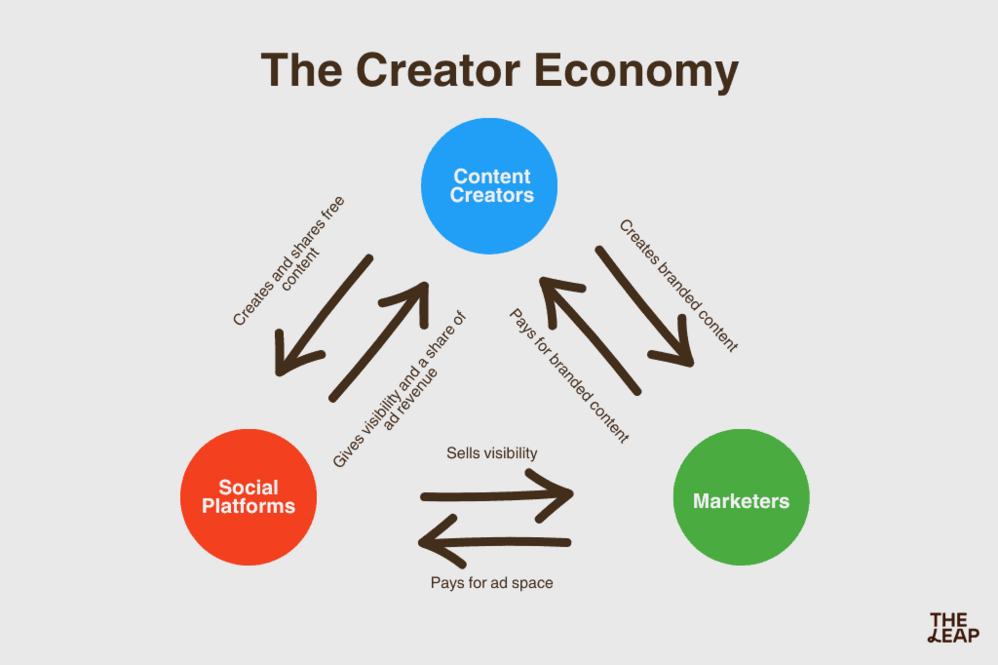
The creator economy—where people make money by sharing content online—has exploded over the past decade. Think YouTubers, TikTokers, bloggers, and podcasters. It used to feel like a wild, free space where anyone with a phone and an idea could build a following and cash in. But things are changing. The creator economy is getting more corporate, with big brands, platforms, and agencies taking control. This shift is reshaping how creators work, what they make, and who gets paid. Let’s dive into what’s happening, why it’s happening, and what it means for creators and fans.

From Bedrooms to Boardrooms
Back in the early days, the creator economy was scrappy. People filmed videos in their bedrooms, wrote blogs from coffee shops, or recorded podcasts in their garages. The vibe was DIY—do it yourself. Creators had direct relationships with their fans. They’d post raw, unpolished content, and people loved it for its realness. Money came from things like ad revenue, fan donations, or small sponsorships.
Now, the scene looks different. Big companies have noticed how much influence creators have. Brands like Nike, Coca-Cola, and even tech giants like Google are pouring money into partnerships with influencers. Agencies that manage creators are popping up everywhere, acting like middlemen. These agencies negotiate deals, handle contracts, and push creators to make content that fits corporate goals. It’s less about “here’s my random vlog” and more about “here’s a polished ad disguised as a vlog.”
Why the shift? Simple: money. The creator economy is worth billions. A 2023 report estimated it at over $100 billion globally, and it’s growing fast. Companies want a slice of that pie. They’re not just sponsoring creators anymore—they’re trying to control the whole game.
Platforms Call the Shots
The platforms where creators post—like YouTube, TikTok, Instagram, and Twitch—are also getting more corporate. These companies aren’t just neutral spaces anymore; they’re setting rules that shape what creators can say and do.
Take algorithms, for example. Platforms use algorithms to decide which videos or posts get seen. Creators used to game these algorithms by posting often or using catchy thumbnails. But now, platforms are tweaking their systems to favor content that aligns with their business goals. For instance, TikTok might push videos that keep users on the app longer, while YouTube might prioritize content that pairs well with ads. If your video doesn’t fit the platform’s agenda, it might not reach your audience, no matter how good it is.
Platforms are also rolling out their own monetization tools, like TikTok’s Creator Fund or YouTube’s Partner Program. Sounds great, right? More ways to make money! But there’s a catch. These programs often come with strict rules. Creators have to hit certain view counts, avoid “controversial” topics, or follow specific formats. It’s like working for a boss who controls your paycheck and your creative freedom.
The Rise of Creator Agencies
Another big change is the rise of creator agencies. These are companies that represent influencers, kind of like how Hollywood agents manage movie stars. Agencies like CAA (Creative Artists Agency) and Viral Nation sign up creators and handle their deals with brands. They take a cut of the money—sometimes 20% or more—but promise to get creators bigger paychecks and better opportunities.
For some creators, this is a dream. They get to focus on making content while the agency deals with emails, contracts, and negotiations. Top influencers like MrBeast or Charli D’Amelio rely on teams to manage their empires. But for smaller creators, agencies can feel like a trap. They might push you to make content that doesn’t feel authentic, like promoting products you don’t believe in. Plus, that agency cut can eat into your earnings, especially if you’re not making millions.
Agencies also make the creator economy less equal. Big agencies tend to work with creators who already have huge followings, leaving smaller or niche creators out in the cold. It’s harder for new voices to break through when the system favors the stars.
Brand Deals Over Fan Love
Remember when creators would thank their fans for every milestone? “We hit 10,000 subscribers, you guys are amazing!” That still happens, but the focus is shifting. More creators are chasing brand deals—lucrative contracts where they promote products or services. A single sponsored post on Instagram can earn thousands of dollars, way more than ad revenue or fan donations.
Brands are picky, though. They want creators to follow strict guidelines: use these hashtags, mention the product this many times, make the video feel “organic” but not too organic. The result? Content that feels more like an ad than a personal story. Fans notice. Scroll through the comments on a sponsored post, and you’ll see things like “Sellout!” or “This doesn’t feel like you.”
The pressure to land brand deals also changes what creators talk about. If you’re a beauty vlogger, brands might want you to stick to makeup tutorials and avoid “risky” topics like politics or mental health. Over time, creators might self-censor to keep the money flowing. It’s not just about losing creative freedom—it’s about losing the connection with fans who loved the real, unfiltered you.
The Corporate Creator
Some creators are going full corporate themselves. They’re not just making videos—they’re building businesses. Take Emma Chamberlain, who started as a YouTube vlogger and now runs Chamberlain Coffee, a legit company with products in stores. Or MrBeast, who’s got his own burger chain and a philanthropy arm. These creators are CEOs, hiring teams, raising investor money, and thinking about profit margins.
This is exciting for creators who want to scale up, but it’s not for everyone. Running a business takes time and energy away from creating. Smaller creators might feel pressure to “go big” when they’d rather just keep making videos. Plus, the corporate creator model favors people who already have money, connections, or business know-how. It’s another way the creator economy is becoming less accessible to regular folks.
The Cost of Going Corporate
So, what’s the downside of all this? For creators, the corporate takeover means less freedom. You’re not just making what you love—you’re making what brands, platforms, or agencies want. That can lead to burnout. A 2022 survey found that 40% of creators felt stressed about keeping up with platform changes and brand demands. Some even quit because the joy of creating was gone.
For fans, the corporate creator economy feels less personal. When every video is sponsored or polished to perfection, it’s hard to feel connected. Fans might start tuning out, which hurts creators in the long run. And for new creators trying to break in, the barriers are higher. You need slick production, a big following, or an agency to get noticed, which shuts out people who don’t have those resources.
There’s also a bigger issue: inequality. The creator economy used to feel like a place where anyone could succeed. Now, the wealth is concentrated at the top. A 2023 study showed that the top 1% of creators earn over 50% of the money in the industry. Meanwhile, smaller creators struggle to make a living, even with thousands of followers.
Can Creators Stay Independent?
Is there a way to fight the corporate tide? Some creators are trying. They’re focusing on direct fan support through platforms like Patreon, Substack, or OnlyFans. These let creators earn money without relying on brands or algorithms. For example, a YouTuber might offer exclusive videos to Patreon supporters, while a writer might charge for a Substack newsletter.
Others are building their own platforms. Nebula, a streaming service created by YouTubers, lets creators share ad-free content and keep more of the profits. These moves give creators more control, but they’re not perfect. Building a fanbase on Patreon or launching a platform takes time and hustle, and not every creator has that.
Some creators are also pushing back by staying authentic, even if it costs them deals. They might say no to a brand that doesn’t align with their values or make content that’s raw and real, even if it doesn’t go viral. It’s a smaller paycheck, but it keeps their audience loyal.
What’s Next for the Creator Economy?
The creator economy isn’t going back to its DIY roots, but it’s not doomed either. As it gets more corporate, creators will need to find ways to balance money and creativity. Some will lean into the corporate world, building brands and signing with agencies. Others will carve out independent paths, relying on fans and niche communities.
For fans, the challenge is supporting the creators you love. That might mean subscribing, donating, or just engaging with their posts. For platforms, they’ll need to decide whether to keep squeezing creators or give them more room to breathe. And for brands, the trick is partnering with creators without turning their content into soulless ads.
The creator economy started as a rebellion against traditional media—gatekeepers like TV networks and publishers. Now, it’s at risk of becoming its own kind of corporate machine. Whether it can keep its heart and soul depends on the choices creators, fans, and companies make next.




